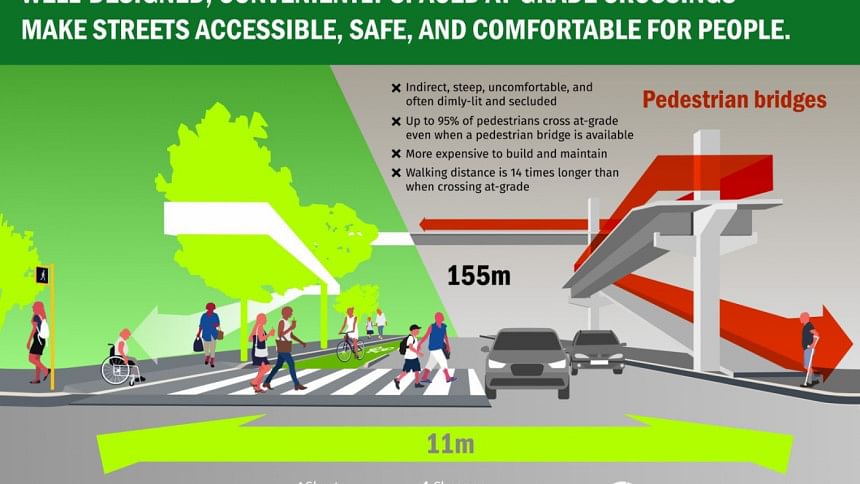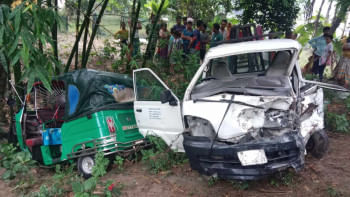Pedestrian-friendly infrastructure paves the way for safer, healthier communities

A few months back while surfing a social media site, a post caught our attention. A renowned daily posted a photo of people crossing a busy road risking their lives instead of using the nearby foot-over bridge. The caption read as follows—"Pedestrians climb over steel fences on the central reservation of a road near the north gate of the Baitul Mukarram national mosque yesterday to go across, putting themselves and the other road users in harm's way. A footbridge is only a few yards away."
The photo and the caption seem to declare the pedestrians guilty of not using the nearby foot-over bridge. And the comment section of the post was filled with condemnation. There is an unfortunately widely accepted myth that foot-over bridges are the best solution for pedestrians to cross a road. Before condemning these people, let's pause and think about other vulnerable users such as a pregnant woman, an elderly person, or someone with knee osteoarthritis, a very common degenerative joint disease for whom climbing a 20-foot-high bridge is nothing but a nightmare.
Recently, we observed six years of the Road Safety Movement but even now roads in Bangladesh have not become safer. According to the Global Status Report on Road Safety 2023 by the World Health Organization, globally, at least 249,900 pedestrians were killed on the roads in 2021. Children and the elderly face even greater risks, highlighting the urgent need for proactive measures. According to the Road Safety Foundation's data, the road crashes of 2022 in Bangladesh killed 1,627 pedestrians. Among them, 51 percent were killed while crossing the road and 60 percent of deaths were caused by speeding. But the only infrastructural solution to prevent these deaths seemed to be the foot-overbridge, which is not a user-friendly solution for all.
Tragically, our roads, which were once shared spaces pulsating with human movement, have been transformed into clogged arteries of asphalt dominated by cars. While ostensibly offering convenience, this shift has come at a significant cost in the form of road injury and death. Pedestrians, the most vulnerable road users, bear the brunt of this imbalance, accounting for a disproportionate share of road fatalities globally. But the tide is turning in many countries. A growing chorus of voices recognises the importance of reclaiming our streets and creating infrastructure that prioritises humans who walk on the streets.
Road crashes involving pedestrians are not just statistics; they are tragedies that ripple through families and affect communities. The loss of a loved one, the physical and emotional trauma of injuries, and the financial burden incurred—these are the real costs of prioritising a car-dependent infrastructure. It's a cost we, as a society, can no longer afford.
Fortunately, the solution isn't complex. By shifting our focus from designing roads for cars to designing roads for people by prioritising the needs of pedestrians, we can create a shield of protection, significantly improving safety. This transformation can take multiple forms such as: raised pedestrian crossings, reducing unnecessary carriageway widths, protected walkways, preventive vehicular access measures on the sidewalks, improved visibility, traffic calming measures, and universal accessibility.

Wide, well-maintained sidewalks separated from lanes offer a safe haven for pedestrians, allowing them to move freely without fear of oncoming vehicles. Raised crosswalks with curb extensions, narrowed lanes, bollards, and speed humps will encourage people to walk. Imagine the relief knowing that you have ample time and the designated space to safely cross the street, instead of weaving dangerously between moving vehicles. Also, the users' common behaviour of walking on the carriageway suggests that people find comfort in walking at grade level and find it difficult to walk on the sidewalk if its height is more than 150 mm.
Raised pedestrian crossings or safety crossings with proper speed calming measurements is a proven and effective solution in most countries rather than constructing a foot-over bridge. Speed humps, roundabouts, and narrower lanes act as physical deterrents against speeding, creating a calmer environment for pedestrians. Also, the unnecessary carriageway widths create residual spaces on the road, which are often occupied by unauthorised parking, thus creating obstacles for pedestrians. Proper placement of ramps, designated areas for people with disabilities, safe waiting spaces while crossing long distances, and design speeds lower than 30kmph, foster inclusivity and safety. Also, placing bollards on the entrances to the pedestrian zones to prevent vehicle access, especially motorbikes, keeps people safe while walking.
The benefits of pedestrian-friendly infrastructure extend far beyond just safety. It creates a ripple effect of positive outcomes. It encourages walking and cycling, promotes healthier lifestyles and combats chronic diseases like overweight and heart disease. Fewer cars on the road mean less congestion, which benefits everyone. Vibrant streets with walkable spaces create more enjoyable and engaging communities. Reduced reliance on cars leads to lower emissions and a cleaner environment. We can learn much from the examples set by Dutch cities that have changed from a car-centric to pedestrian-centric environment. Over the past few decades, there has been a sharp decrease not only in the number of children killed in road crashes but a marked improvement in the quality of air and traffic congestion.
Building and maintaining pedestrian-friendly infrastructure requires investment, but the benefits far outweigh the costs. It's an investment in our communities' health, safety, and well-being, which creates a more liveable and sustainable future for all. We believe that the continued efforts by our city authorities to adapt and accept the best practices from developed countries will make our streets safe for all its users.
Farzana Islam Toma is architect and consultant at Sustainable Cities and Transport Program of World Resources Institute.
Mahamudul Hasan is communications officer at Bloomberg Philanthropies Initiative for Global Road Safety (BIGRS) in Chattogram.
Views expressed in this article are the author's own.
Follow The Daily Star Opinion on Facebook for the latest opinions, commentaries and analyses by experts and professionals. To contribute your article or letter to The Daily Star Opinion, see our guidelines for submission.

 For all latest news, follow The Daily Star's Google News channel.
For all latest news, follow The Daily Star's Google News channel. 










Comments